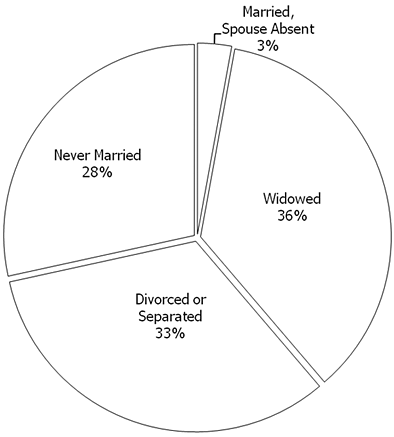Newsletters
- Home
- Publications
- Newsletter Archive
- Newsletter
November/December 2011
Inside This Issue:
- Research Examines Drilling's Impact on Drinking Water
- Chairman's Message
- Research Explores Viability, Sustainability of State's Main Street Programs
- Center Board Holds Summer Meeting in Lycoming County
- Living Alone and Liking It
- Just the Facts: County Characteristics by Top Industry Employers
Research Examines Drilling's Impact on Drinking Water
The Center for Rural Pennsylvania has released the finding of a 2010-2011 study of private water wells in the Marcellus Shale drilling regions of Pennsylvania. The research, conducted by Dr. Elizabeth Boyer, Bryan Swistock, James Clark, Mark Madden and Dana Rizzo of Pennsylvania State University, provides an unbiased and large-scale study of water quality in private water wells in rural Pennsylvania both before and after the drilling of nearby Marcellus Shale gas wells. It also documented the enforcement of existing regulations and the use of voluntary measures by homeowners to protect water supplies.
The research found that approximately 40 percent of the water wells failed at least one Safe Drinking Water Act water quality standard, most frequently for coliform bacteria, turbidity and manganese, before gas well drilling occurred. In this study, this existing pollution rate and the general characteristics of the water wells, such as depth and construction, were similar to past studies of private water wells in Pennsylvania.
The research analyses of post-drilling versus pre-drilling water chemistry also suggested no major influences from gas well drilling or hydrofracturing (fracking) on nearby water wells when considering changes in potential pollutants that are most prominent in drilling waste fluids.
The research also found that a standardized list of minimum required water testing parameters, including bromide, should be required across all pre-drilling surveys to eliminate many questions and confusion among water supply owners.
Because of the increased bromide concentrations and sporadic sediment and metals increases observed in wells within 3,000 feet of Marcellus gas well sites, the research also suggests that a 3,000 foot distance between the location of gas wells and nearby private water wells is a more reasonable distance for both “presumed responsibility” and certified mail notification related to Marcellus gas well drilling than the 1,000 feet that is currently required.
Research methods
The researchers evaluated water sampled from 233 water wells in proximity to Marcellus gas wells in rural regions of Pennsylvania in 2010 and 2011. Among these were both treatment sites and control sites.
Phase 1 of the research focused on 48 private water wells located within about 2,500 feet of a nearby Marcellus well pad. Phase 2 focused on an additional 185 private water wells located within about 5,000 feet of a Marcellus well pad.
During Phase 1, the researchers collected both pre- and post-drilling water well samples and analyzed them for elements of water quality at various analytical labs.
During Phase 2, the researchers or homeowners (after training) collected only post-drilling water well samples, which were then analyzed for elements of water quality. The post-drilling analyses were compared with existing records of pre-drilling water quality, which had been previously analyzed at state-accredited labs, from these wells.
Research results
The study’s pre-drilling results for dissolved methane provided new information that documented its occurrence in about 20 percent of water wells, although levels were generally far below any advisory levels.
Despite an abundance of water testing, many private water well owners had difficulty identifying pre-existing water quality problems in their water supply. The lack of awareness of pre-drilling water quality problems suggests that water well owners would benefit from unbiased and consistent educational programs that explain and answer questions related to complex water test reports.
In this study, statistical analyses of post-drilling versus pre-drilling water chemistry did not suggest major influences from gas well drilling or hydrofracturing (fracking) on nearby water wells, when considering changes in potential pollutants that are most prominent in drilling waste fluids. When comparing dissolved methane concentrations in the 48 water wells that were sampled both before and after drilling (from Phase 1), the research found no statistically significant increases in methane levels after drilling and no significant correlation to distance from drilling. However, the researchers suggest that more intensive research on the occurrence and sources of methane in water wells is needed.
According to the Pennsylvania Oil and Gas Act of 1984, gas well operators are “presumed responsible” for pollution of water supplies within 1,000 feet of their gas well for six months after drilling is completed if no pre-drilling water samples were collected from the private water supply. This has resulted in extensive industry-sponsored pre-drilling testing of most water supplies within 1,000 feet of Marcellus drilling operations. However, the research found a rapid drop-off in testing beyond this distance, which is driven by both the lack of presumed responsibility of the industry and also the cost of testing for homeowners.
The research results also indicate that a standardized list of minimum required testing parameters should be conducted across all pre-drilling surveys to eliminate many questions and confusion among both water supply owners and water professionals. The results from this study indicate that this standardized list include bromide among other common parameters, since the research found that bromide levels in some water wells increased after drilling and/or fracking (See error notice below). These increases may suggest more subtle impacts to groundwater and the need for more research. Bromide increases appeared to be mostly related to the drilling process. A small number of water wells also appeared to be affected by disturbances due to drilling as evidenced by sediment and/or metals increases that were noticeable to the water supply owner and confirmed by water testing results.
Increased bromide concentrations in water wells along with sporadic sediment and metals increases were observed within 3,000 feet of Marcellus gas well sites in this study. These results suggest that a 3,000 foot distance between the location of gas wells and nearby private water wells is a more reasonable distance for both presumed responsibility and certified mail notification related to Marcellus gas well drilling than the 1,000 feet that is currently required.
According to the research, regulations requiring certified mail notification of water supply owners, chain-of-custody water sampling protocols, and the Pennsylvania Department of Environmental Protection’s investigation of water supply complaints were generally followed, with a few exceptions.
However, since voluntary stipulations were not frequently implemented by private water well owners, there may be a greater need for educational or financial resources to help facilitate voluntary testing among well owners.
Since the research was limited to the study of relatively short-term changes that might occur in water wells near Marcellus gas well sites, the researchers suggest that additional monitoring at these sites or other longer-term studies are needed to provide a more thorough examination of potential water quality problems related to Marcellus gas well drilling.
Report available
For a copy of the research results, The Impact of Marcellus Gas Drilling on Rural Drinking Water Supplies, call or email the Center for Rural Pennsylvania at (717) 787-9555 or info@rural.palegislature.us or visit www.rural.palegislature.us/documents/reports/Marcellus_and_drinking_water_2011_rev.pdf.
(Error notice November 22, 2011: Penn State University researchers have advised the Center for Rural Pennsylvania that they have identified an error in their research findings in the report, "The Impact of Marcellus Gas Drilling on Rural Drinking Water Supplies." This report was presented to, and released by, the Center in October 2011.
The report includes data showing bromide increases in seven water wells after drilling and/or fracking of nearby Marcellus gas wells. The researchers now advise that the bromide concentration data were incorrect due to a lab error from the subcontracted, state-accredited, water testing laboratory. The laboratory has since provided a data update.
According to the University, these updated results show that the occurrence of bromide in water wells after gas drilling or drilling and fracking is not as prevalent as first reported (in 7 wells), but did occur in a single case (1 well). In this case, the increase in bromide was accompanied by increases in chloride, hardness, and other indicators after drilling and fracking had occurred, as documented in the report.
At this time, all research findings are being reviewed. Upon completion of the review, the researchers will develop an errata sheet to reflect all corrected data and analyses. Based on the errata, the Center for Rural Pennsylvania will issue a revised report, which should be available in the coming weeks.
The Center for Rural Pennsylvania apologizes for any inconvenience resulting from this error.)
Chairman's Message
In just a few short years, Marcellus Shale has become the focus of much conversation, debate, and public policy considerations. As with any issue where there are differing opinions, it can be challenging to sift through emotion and hearsay to find factual, unbiased data to start those discussions.
The role of providing factual, unbiased data and research findings has been at the core of the Center for Rural Pennsylvania's mission since 1987. While most of the Center's work has not been on such controversial topics as Marcellus Shale, it has garnered a reputation as a consistently reliable source of information on a comprehensive list of issues facing Pennsylvania's rural communities and citizens.
That reputation continues with the release of the Center's recent report on the impacts of Marcellus Shale gas drilling on private water wells in rural Pennsylvania. The article on Page 1 provides a summary of the findings from a study conducted by a research team from Pennsylvania State University. The results of this research provide important information for the General Assembly as it considers any policy action on future drilling sites and well water construction standards. Copies of the report are available by calling the Center or visiting the Center's website.
The Center's focus on the issue of Marcellus Shale and its impact on rural Pennsylvania does not stop with this report. At its quarterly meeting in December, the Center's Board of Directors will make funding decisions on its 2012 research portfolio. One of the research projects being considered is a longitudinal study of the economic and community impacts of Marcellus Shale development. The approved research, which will be conducted over a six-year period in two regions of the state, will document impacts on revenue and job creation, business startups and expansion, agriculture, forestry and wood products, education and workforce development, health care, human services, public safety and emergency services, education, housing, roads and bridges, telecommunications, and water and sewage. The objective of this research will mirror that of other Center-sponsored research projects: to promote and sustain the vitality of Pennsylvania's rural and small communities by informing and educating audiences about the diverse people and communities of rural Pennsylvania and the issues affecting them.
As the year comes to a close, it is time once again to offer thanks, celebrate holidays, and gather with family and friends. I hope you enjoy this great time of year.
Senator Gene Yaw
Research Explores Viability, Sustainability of State's Main Street Programs
Since its introduction to Pennsylvania in the early 1980s, the Main Street Program (MSP) has played an active role in community revitalization in more than 140 communities.
To explore the viability and sustainability of these programs in Pennsylvania, Drs. Chad Kimmel and Joel Schoening of Shippensburg University of Pennsylvania examined existing data and surveyed Main Street managers in 2010 to develop policy considerations that may support the continued viability and sustainability of these programs.
The research was sponsored by the Center for Rural Pennsylvania.
Research definitions, data sources
For the research, sustainable programs were defined as those that had stability in leadership, governance, finances and staffing.
The research used existing data from the Pennsylvania Downtown Center, which is the statewide, nonprofit that contracts with the Pennsylvania Department of Community and Economic Development (DCED) to provide MSP communities with technical assistance and educational services.
The research also used data from the U.S. Census Bureau, gathered new data from a mail questionnaire of Main Street managers, and conducted site visits to a selection of MSPs throughout the state.
Two significant predictors of sustainability
According to the results, two variables emerged as significant predictors of MSP sustainability: the existence of a Business Improvement District (BID) and managers' perceived effectiveness at using the Main Street Four-Point Approach.
A BID is a voluntary local assessment of businesses and property owners that helps to generate revenue for a variety of downtown investments, such as streetscape improvements and additional security or maintenance.
The Main Street Four-Point Approach is the primary community revitalization strategy adopted by the National Trust for Historic Preservation's Main Street Initiative. It is made up of four components: promotion, economic restructuring, design and organization.
The research results also indicated that community buy-in is a strong indicator of a program's sustainability/success as well as the length of service of the Main Street manager. The average manager turnover rate was about 1.5 years.
The research found that, with most managers leaving programs after just 18 months, it is difficult for programs to create momentum, establish legitimacy, and begin building the deep organizational roots and partnerships within their respective communities that are needed to accomplish program goals.
More focus on manager retention, training
In terms of policy, the researchers suggest that consideration be given to manager retention and increased training opportunities.
The researchers also recommend that DCED take the lead in assessing and evaluating programs, and that the Pennsylvania Downtown Center maintain its role in providing technical assistance, training and education to MSPs.
The researchers also recommend that the reporting structure for MSPs be changed from the Pennsylvania Downtown Center to DCED. In doing so, greater oversight and accountability should be initiated if data gathered from MSPs is to have any real impact on measuring the effectiveness of state investment.
Report available
For a copy of the research results, An Evaluation of Pennsylvania's Main Street Programs, call or email the Center for Rural Pennsylvania at (717) 787-9555 or info@rural.palegislature.us or visit www.rural.palegislature.us/documents/reports/Main_Street_Program_2011.pdf.
Center Board Holds Summer Meeting in Lycoming County
Keeping with its annual tradition of holding its summer board meeting in rural Pennsylvania, the Center for Rural Pennsylvania's Board of Directors this year traveled to Lycoming County.
Senator Gene Yaw, Center board chairman, hosted the quarterly meeting at Pennsylvania College of Technology in Williamsport on September 30.
Dr. Davie Jane Gilmour, president of Pennsylvania College of Technology, welcomed the board to the college and provided a tour of the campus after the meeting.
At the meeting, board members were updated on the results and progress of several Center-sponsored research projects.
Dr. Martha Troxell and Dr. Erika Frenzel-Davis of Indiana University of Pennsylvania reviewed the results of the recently published report on specialty courts in rural Pennsylvania.
The results of that research, Specialty Courts in Pennsylvania: Establishment, Practice and Effectiveness, are available on the Center's website at www.rural.palegislature.us.
Dr. Gary Zajac of Pennsylvania State University provided progress reports on two research projects that he is currently conducting. The first is focusing on Pennsylvania State Police coverage in rural municipalities and the second is looking at Pennsylvania's rural county prison systems.
Bryan Swistock of Pennsylvania State University presented the results of his team's research on Marcellus gas drilling and rural drinking water. The results of that research are featured above.
The day before the meeting, board members and Center staff went on an informational tour of an Anadarko Petroleum natural gas drilling site in Clinton County.
At past summer board meetings, board and staff have traveled to Columbia, Clinton, Berks, Bradford, Venango and Schuylkill counties and have toured manufacturing facilities, a landfill and recycling operation, farms and vineyards, health care facilities, Main Street communities, historic buildings, museums and schools.

Pictured above from left are: Taylor Doebler, board member; Elizabeth Greville, representing board member Dr. Livingston Alexander;
Dr. Theodore Alter, board member; Dr. Karen Whitney, board member; Dr. Davie Jane Gilmour, Pennsylvania College of Technology president;
Sen. Gene Yaw, board chairman; Dr. Nancy Falvo, board secretary; and Steve Brame, board member. Photo by Joseph S. Yoder.

Pictured above from left are: Taylor Doebler; Steve Brame; Brian Mitchell of Anadarko Petroleum;
Dr. Nancy Falvo; Sen. Gene Yaw; Barry Denk, director of the Center for Rural Pennsylvania;
and Elizabeth Greville. Photo by Nick Troutman.
Living Alone and Liking It
More than 377,800 rural Pennsylvania householders lived alone in 2010, according to data from the U.S. Census Bureau. That's roughly 11 percent of the total rural household population.
From 2000 to 2010, the number of rural persons living alone increased 10 percent.
In urban Pennsylvania, 1.06 million householders lived alone, or about 12 percent of the urban household population. From 2000 to 2010, the number of urban persons living alone increased 8 percent.
Nationally, 31.2 million people lived alone or 10 percent of the household population. From 2000 to 2010, the number of people living alone increased 15 percent.
Among all states, Pennsylvania had the 12th highest percentage of people living alone (11 percent). North Dakota had the highest percentage (13 percent) while Utah had the lowest (6 percent).
In rural Pennsylvania, a higher percentage of females (55 percent) than males (45 percent) live alone.
According to data from the 2005-09 American Community Survey's Public Use Microdata Sample (ACS-PUMS), the average age of a rural person living alone was 59.8 years old. However, the average age of rural males who lived alone was 52.9 years old and the average age of females who lived alone was 65.
Of those living alone in rural Pennsylvania, 36 percent were widowers, 33 percent were separated or divorced, 28 percent were never married, and 3 percent were married but their spouse was absent due to factors such as prison, military service, or out-of-area employment. However, when looking at the data in terms of gender, there were significant differences. For example, 50 percent of rural women living alone were widowed compared to 17 percent of men. In addition, 39 percent of men were never married compared to 20 percent of women.
Among all rural residents living alone, 60 percent lived in their own home and 40 percent were renters.
Approximately 19 percent of those living alone did not have access to a vehicle.
The median household income of rural residents living alone was $21,489. In comparison, rural married couples had a median household income of $61,556, a difference of more than $40,000.
The poverty rate among those living alone was 19 percent. However, those under 35 years old had a higher poverty rate (25 percent) than those 35 years old and older (19 percent).
Among those living alone, 44 percent were employed, 3 percent were unemployed, and 53 percent were not in the labor force.
Data from a 2008 Attitudinal Survey of Rural Pennsylvania Residents, sponsored by the Center for Rural Pennsylvania, indicates that many rural residents who live alone are content. According to that survey, which included 1,251 rural individuals, 16 percent of whom lived in a one-person household, 80 percent said they seldom or never felt depressed or very unhappy; 75 percent said they seldom or never felt bored; and 66 percent said they felt that things were going their way. In addition, 48 percent described their level of involvement in the community or in local activities or events as somewhat active to very active. And while they lived alone, 74 percent said they had five or more friends living in the area and 50 percent said they had five or more relatives living in the area.
Marital Status of Rural Residents Living Alone, 2005-09

Just the Facts: County Characteristics by Top Industry Employers
The top industry employers in Pennsylvania are government, healthcare, and manufacturing, according to fourth quarter 2010 data from the Pennsylvania Department of Labor and Industry's Center for Workforce Information and Analysis.
According to 2010 Census Bureau data, in rural counties where government, including local, state, and federal, is the top employer, there was a 4 percent population increase from 2000 to 2010. In rural counties where manufacturing is the top employer, there was a 5 percent population increase, and where healthcare is the top employer, there was a population decline of about 2 percent.
In rural counties where healthcare and government are the top employers, the poverty rate was 3 percentage points higher than in rural counties where manufacturing was the top employer (13 percent vs. 10 percent, respectively).
In rural counties where government is the top employer, the unemployment rate was more than 9 percent in the fourth quarter of 2010. In rural counties where healthcare and manufacturing are the top employers, the unemployment rates were 8 percent each.
Where manufacturing is the top employer in rural counties, 20 percent of the adult population (25 years and older) had a bachelor's degree or higher. Where government and healthcare dominated, approximately 17 percent of the adult population had a bachelor's degree or higher.
In urban counties where healthcare is the top employer, there was a population increase of about 10 percent. In urban counties where manufacturing is the top employer, the population increased 5 percent and where government is the top employer, the population remained steady.
In urban counties where government is the top employer, the poverty rate was nearly 17 percent in 2010. In urban counties where healthcare and manufacturing are the lead employers, the unemployment rates were 10 and 9 percent, respectively.
Where manufacturing is the leading employer in urban counties, 34 percent of the adult population had a bachelor's degree or higher. Where healthcare and government are the top employers, approximately 23 and 26 percent, respectively, had a bachelor's degree or higher.
